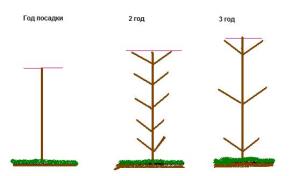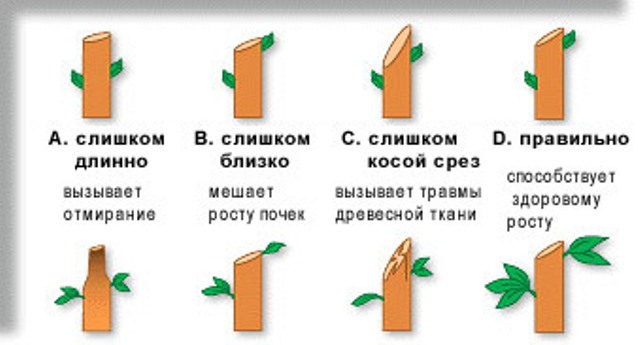Cut the columnar apple tree correctly
Everyone, especially in the summer, loves to enjoy delicious apples that were grown on their own land. But besides a simple desire, you also need to work hard to get your own apples. Most of the energy is spent on growing an apple tree.
Here we will try to figure out all the nuances of caring for such a species as a columnar apple tree. What needs to be done in order not to harm the tree, but to help ensure its full growth.
Content
Do I need to prune columnar apple trees
With proper planting, a columnar apple tree during the first year during the growing season grows by about 40 cm.At the same time, you should not strive for the tree to actively grow upward, as this will not have any effect on fruiting.
In case of damage or freezing of the apical kidney, in young trees several strong shoots develop, which are located slightly below the top. In this case, the strongest shoot should be chosen - it will be the main one, and the rest must be shortened.
For productivity, it is important to timely carry out activities that are aimed at protecting trees from a variety of pests, weeds, diseases and rodents. There are certain varieties of columnar apple that are resistant to certain types of diseases. In this case, preventive measures are carried out at the beginning of the growing season. If cancerous wounds have formed on the tree trunk, then they must be cleaned and then treated with a mixture of mullein and clay in a 1: 1 ratio.
All of the above actions regarding planting and growing columnar apple trees will help the gardener achieve a large annual yield and extend the tree's fruiting period.
The structure of the trunk of a columnar apple tree is characterized by the overgrowth of the entire tree with ringlets, which prevents the formation of a large number of lateral shoots. Experienced gardeners argue that pruning is not always necessary to maintain the correct crown shape. After all, the apical bud on the tree should not be damaged or disturbed under any circumstances. A tree is able to maintain a relatively correct shape of its crown throughout its life and a person does not have to perform certain intentional actions in order to maintain the appropriate appearance of the columns. As a result, pruning of columnar apple trees, as a way to maintain the crown of a tree, is not very effective in this case.
Therefore, each gardener determines the question of the need for pruning for himself. It all depends on individual preferences. If you want to get a strict and classic columnar shape, then the crown of the tree must be cut off after a certain period of time. In this case, only small and young shoots should be cut off, the age of which is less than a year. It is also necessary to leave a couple of buds at the base of the shoot. As a result, you can get a beautiful crown and not harm the fruit. But if this is not a matter of principle and you are satisfied with the slightly "disheveled" appearance of the tree crown, in this case, pruning may well be omitted. This will make your apple tree look more natural and natural.
But at the same time, you should definitely remember about the peculiarity of columnar apple trees - buds are laid throughout the tree (even on the trunk) and therefore the presence of a large number of lateral branches will select a lot of nutrients that could go to the formation of fruits.
It is this aspect that to some extent outweighs the scales in favor of pruning.
Pruning a columnar apple is necessary under certain conditions:
- improved fruiting. In this case, when the yield decreases due to the fact that the life of the tree is coming to an end, you can carry out the so-called "rejuvenating" pruning. For this in the spring (March, April) cut trees with one trunk at a level of 70 cm. This will stimulate the growth of new shoots. Then, you need to choose the strongest trunk, and cut the rest this year. In the case when a tree is formed using several trunks, the approach to pruning should be individual;
- as a way to increase yields, pruning can be used under unfavorable conditions that negatively affect this indicator (for example, during a drought period) and to improve tree nutrition.
But why do some experienced gardeners still insist that pruning of this type of tree is necessary? This statement builds on the advantages that pruning brings with its simplicity:
- allows you to form a beautiful and correct shape of the crown of a tree;
- prevents branches from tangling together if they are densely planted;
- allows you to strengthen young branches on the apple tree;
- allows the fruit of the tree to receive much more sunlight than without pruning;
- by pruning, old branches can be strengthened and rejuvenated, as well as replaced with younger ones.
Based on the foregoing, we can conclude that pruning is more useful and beneficial than no pruning. So it is better to spend a couple of hours pruning trees and get a more succulent crop, as well as increase its volume.

Formation of a columnar apple tree
Features and pruning scheme
If you do decide that pruning is necessary, you should follow certain rules to prevent a decrease in yield and not cause irreparable damage to the tree as a whole.
The main rule that must be adhered to is that the more is cut, the more active the growth of the remaining side shoots will be. Therefore, you can cut off more than half of the branch at a time, while leaving only a couple of buds on it. This will lead to the fact that by the fruiting season, young shoots will become the most powerful. But it should be remembered that in no case should the apical kidney be cut off or damaged.
You also need to remember that the closer the branch is to the vertical, the stronger it grows in relation to the underlying deflected branches. Removing them will prevent unnecessary forks from forming. For this reason, the center conductor at the column is not trimmed. In order for you to succeed, and the result is pleasing to the eye, you must adhere to the correct scheme.
The scheme of the formation of columnar apple trees:
- 1st year or planting year - the main trunk of the apple tree and all its lateral branches are cut;
- 2nd year - all lateral shoots are split to a length of about 30 cm. At the same time, the upper shoot remains unchanged - it will serve as a continuation of the trunk in the future;
- 3rd year - it is necessary to pinch the upper shoot approximately at the level of 20-25 cm, and the pinching of the lateral shoots is carried out at a level of up to 40 cm;
- 4th year - this year in the spring the branches of the 3rd year are thinned out, and the thinnest and smallest ones growing inside the crown and leading to shading of each other are removed;
- 5th year - the growth of the tree is limited at a height of about 3 m. In June, green shoots should be pinned and thickening branches should be removed;
- 6th year and beyond - it is necessary every spring to remove the growing and thickening shoots that have remained from last year.
This procedure at different times of the year (spring, early summer or in preparation for winter) requires certain work.

Scheme for the correct pruning of branches
To achieve the best result, you must follow the following rules:
- only young annual shoots are subjected to the procedure;
- it is imperative to leave a couple of buds at the base of each cut branch;
- In the middle of summer, intensively growing shoots can be limited with a special clothespin to help distribute nutrients in the tree itself, and not let them into growth shoots and leaves. Such actions can significantly improve the quality of the crown, as well as the entire tree as a whole;
- one year after the first pruning, the lateral branches should be cut into two buds. This is repeated the next year. In the third year, in the summer, a horizontal branch that has not been cut will bear fruit, and a vertical one - two young shoots. Such a fruit link will bear fruit for five years, and then it is removed and the lower part of the tree is exposed;
- the apical or crown shoot must be tied to a support, but fruit links should be formed from the rest.
The rules for pruning the apical shoot:
- in the first year after planting the tree, it is necessary to cut the side branches into two buds. This must be done before the period of sap flow, which will allow a pair of annual and strong shoots to grow;
- in the second year, one of the new shoots is cut into two buds;
- in the third year, the branch that bore fruit last year must be cut off, and with the rest of the shoots, repeat the procedure for the second year.
Video "Pruning a columnar apple"
The rules for pruning a columnar apple tree can be found in the video.
Proper care and pruning of columnar apple trees will not only help you get a large and annual harvest, but also give your garden a neat and well-groomed look that will delight the eye.
